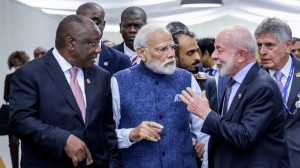P. Vaidyanathan Iyer is The Indian Express’s Managing Editor, and leads the newspaper’s reporting across the country. He writes on India’s political economy, and works closely with reporters exploring investigation in subjects where business and politics intersect. He was earlier the Resident Editor in Mumbai driving Maharashtra’s political and government coverage. He joined the newspaper in April 2008 as its National Business Editor in Delhi, reporting and leading the economy and policy coverage. He has won several accolades including the Ramnath Goenka Excellence in Journalism Award twice, the KC Kulish Award of Merit, and the Prem Bhatia Award for Political Reporting and Analysis. A member of the Pulitzer-winning International Consortium of Investigative Journalists (ICIJ), Vaidyanathan worked on several projects investigating offshore tax havens. He co-authored Panama Papers: The Untold India Story of the Trailblazing Offshore Investigation, published by Penguin. ... Read More
To build dollar reserves, India looks at deal with US Fed, European Bank
In what will put overwhelming dollar power in India’s hands, the government is considering, for the first time...

In what will put overwhelming dollar power in India’s hands, the government is considering, for the first time, a currency swap arrangement with the United States Federal Reserve Bank or the European Central Bank (ECB), the central bank for Europe’s single currency.
Such a deal — essentially a stand-by facility — will allow the Reserve Bank of India to get billions of dollars or euros by swapping equivalent rupees at a pre-determined price. It is seen as an additional cushion to India’s still comfortable foreign exchange reserves position.
A currency swap is an arrangement between two parties to exchange a specified amount of each other’s currency during a given time-period at mutually acceptable terms. It can either be a straight cash swap or can even be negotiated as a government securities swap to ensure that it does not affect liquidity in the domestic market.
“It is far cheaper than other sources of credit,” a senior Finance Ministry official told The Sunday Express. He said the government is assessing its requirements before it negotiates a swap arrangement with the US Fed and the ECB. The swaps will not only boost sentiments in the foreign exchange market, but will also give confidence to companies requiring dollar funding. “You put them up, so that you don’t use them. They show you have overwhelming power,” another official added.
In the backdrop of the global financial turmoil and the resulting credit crisis, central banks of emerging economies such as Korea, Mexico, Brazil and Singapore had on October 30-31 negotiated temporary swap lines of credit with US Federal Reserve. This was meant to mitigate the difficulties in getting dollar funding in their countries which otherwise had fundamentally sound and well-managed economies.
A sharp dip in forex reserves of almost $63 billion in India during the last six months to $246 billion now has raised some concern in the government. However, according to finance ministry officials, almost $30 billion or half of the depletion in reserves is on account of revaluation, or what is called losses due to mark-to-market. India’s forex reserves are deployed in various international currencies, predominantly US dollar, euro, yen and sterling. A sharp appreciation of the dollar against the euro or sterling will result in a reduction in the value of these currencies in dollar terms.
“We are looking at the balance of payments position in a fairly intensive manner — whatever major dip or decline had to happen has already taken place. We have a general fix on the global oil prices now and do not expect the BoP to be very negative going forward after factoring in the capital outflows,” the Finance Ministry official said.
CEO of ICICI Bank K V Kamath said it made sense to have a stand-by line of credit when one is available. “It gives dollar access without necessarily putting reserves on the line,” he said. According to him, India has a one-year liability of $65 billion, including NRE deposits of $35 billion and suppliers credit of $15-20 billion.
Another economist with a foreign institutional investor who did not wish to be named said, “Even Singapore has copious reserves, but it negotiated a swap with the US.” Given the way countries are trying to coordinate policies and currency movement, a swap gives a little bit of more comfort to investors. “Technically, when corporates convert rupees to dollars, RBI can use the swap,” he said. Essentially, these are instruments that act as good deterrents.
•What is a currency swap?
Negotiated deal with the US wherein the RBI gets a dollar line of credit that it can tap if there is any sudden and huge demand for dollars either by India Inc or other liabilities. India can also strike a euro swap with the European Central Bank.
•What could be the size of such a swap?
US Fed inked swap arrangement with Brazil, Korea, Mexico and Singapore for $30 billion. It could be similar or more for India.
•How does it help?
In last six months, India’s forex reserves have dipped by $60 billion to $246 billion. A swap will be a cushion giving dollar power. It’s also about perception given that India’s one-year liabilities are to the tune of $ 65 billion. Boosts foreign exchange market sentiments, investor confidence, acts like a second line of defence
•Does India need to exercise it?
No. It’s essentially a stand-by facility. Swaps are powerful instruments put up by countries, not necessarily to use them. But they are effective back-stopping devices.








- 01
- 02
- 03
- 04
- 05
























